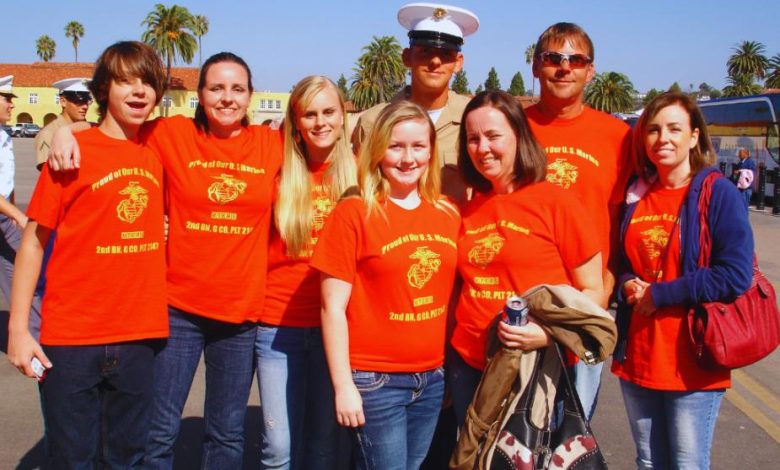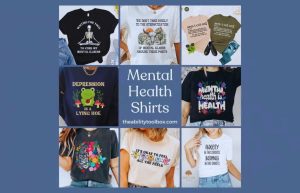Express Yourself: The Power of Mental Health T-Shirts”

Introduction: Express Yourself: The Power of Mental Health T-Shirts
Mental health t-shirts have emerged as an interesting phenomenon in the kaleidoscope world of fashion, where fads ebb and flow like tides of communal consciousness. Originally confined to the margins of counterculture, these sartorial declarations have grown into a full-fledged movement, and a thread of awareness is woven across the fabric of society.
The paradox of apparent invisibility
Long veiled in obscurity and stigma, mental health now finds itself boldly displayed on chests in a brilliant spectrum of colors and typefaces. Wearing one’s heart, or more precisely one’s mind, on one’s sleeve, is a contradictory act of making the invisible visible. But what celestial alchemy transforms cotton and ink into change agents?
Imagine a sea of individuals each bearing a distinct mental health message. “Depression Doesn’t Define Me,” says one shirt in strong, rebellious lettering. Still another murmur in the delicate script: “It’s Okay Not to Be Okay.” Every piece of clothing transforms into a silent cry in a world too often subdued by misinterpretation, a walking billboard, a mobile conversation starter.
The Quantum Entanglement of Feeling and Fashion
Let us, however, delve deeper into the rabbit hole of this phenomenon. Mental health t-shirts are in a condition of quantum superposition, meaning they are both quite personal and generally relevant. They are both armor and vulnerability, a shelter from criticism and a clear call to interact.
Think of their impact as fractal. One person strikes up a discussion with a stranger based on their outfit. Touching the interaction, that stranger purchases their shirt. The knock-on effects keep building a complicated network of awareness and empathy that resists straight development.
Empowerment: The Alchemy
The real beauty of mental health t-shirts, though, is their alchemical potential to transform guilt into pride and loneliness into camaraderie. Their aesthetic appeal is secondary. They are talismans of sorts, charged with the ability to stifle stigma and inspire compassion.
But beware of the siren song of marketing! As mental health becomes increasingly popular, fast fashion and fake virtue signaling run the risk of co-opting these strong emblems. The challenge is staying true in a society ravenous for the next popular hashtag.

Semiotics of Self-Expressiveness
A deeper exploration of the rabbit hole reveals the labyrinthine field of semiotics, the study of signs and symbols. Mental health t-shirts are more than just clothing; they are sophisticated signifiers loaded with layers of meaning that radiate outward like stones dropped into a cognitive pond.
Think about the typeface used in a shirt declaring “Anxiety Warrior.” While a softer, rounded script might represent kindness and self-compassion, bold, sharp-edged letters might suggest strength and rebellion. Choosing which shirt to wear becomes a subtle kind of self-expression, a daily ritual of matching one’s outside look with interior emotional terrain.
The paradox of collective individuality
Mental health t-shirts provide an intriguing paradox in a world more divided by digital silos and echo chambers: they both recognize uniqueness and strengthen a feeling of group identity. Though each garment conveys a different narrative, when together they create a tapestry of common experience.
This phenomenon reflects the idea of “collective effervescence” put forth by sociologist Émile Durkheim: the energy and communion produced when people gather behind a common goal. Here, the goal is to destigmatize mental health, and the t-shirts act as totems of this group effort.
Temporal Dynamics of Trends and Taboos
We have to consider the complicated interaction of trends and taboos as we map the course of mental health t-shirts from niche statements to mainstream fashion. As these shirts gain popularity, do they run the danger of losing their ability to shock, challenge, and start change?
Maybe their very prevalence is proof that we have passed a threshold in our shared openness to interact with mental health concerns. One may argue that the acceptance of these messages marks a minor but important change in our cultural zeitgeist, so it is a win in itself.

Neuroplasticity of Social Transformation
Neuroscience reveals that our environment and experiences cause our brains to be continually rewired. Could constant exposure to mental health messaging via t-shirts physically change our neural pathways, facilitating more natural and less conflicted conversations about mental health?
This idea of “social neuroplasticity” implies that broad cultural events such as the explosion of mental health t-shirts could be able to influence change not just in a society but also on a neural level. Fashion, as a form of group cognitive behavior therapy, is a seductive idea.
Counting Mental Health: An Ethical Maze
We find ourselves negotiating an ethical maze as mental health t-shirts get traction. One could argue that monetizing these messages results in increased awareness and reach. Conversely, it begs difficult issues of profit from the hardships of others.
How can we prevent exploitation while nevertheless raising knowledge? While some companies give mental health groups some of their earnings, is this sufficient? And how can we make sure that detached from real understanding and action, the very act of wearing these shirts does not become a type of performative allyship?
Future Frontiers of Wearable Wellness
What metamorphoses might mental health t-shirts experience as we gaze ahead into the crystal ball of fashion? Maybe we’ll see smart materials that change color depending on the wearer’s emotions or augmented reality elements giving viewers who scan the shirt with their phone tools.
Alternatively, perhaps the future frontier is in ever more complex and varied depictions of mental health problems, not technological innovation. Shirts that touch the intersectionality of mental health with regard to race, gender, and socioeconomic level. Clothing that questions not only stigma but also the fundamental conceptions and classifications we use to mental health itself.
Finally: The Threads Linking Us
Within the wonderful fabric of human experience, mental health t-shirts are only one thread. Still, they mark a dramatic change in our perception and conversation about mental health. They are evidence of the need for visibility, of owning one’s experience, of discovering strength in fragility.
Let’s not undervalue the simple t-shirt while we negotiate the maze-like complexity of mental health awareness. Because often the most potent words are worn rather than spoken, simplicity reveals a great truth.
Ultimately, maybe the real power of mental health t-shirts is found in their capacity to inspire millions of small revolutions in our hearts, in our perceptions, and in our conversations, not in their ability to overnight transform the world. They remind us that the first step in both personal and group healing is usually just being seen.
Thus, keep in mind the next time you wear a mental health t-shirt: you’re not only getting dressed. You are engaged in a sophisticated social ritual, a silent conversation, a subtle but strong prodding toward a society more sympathetic and understanding. Every thread matters in the fabric of social change.

FAQ: Clarifying the Puzzle of Mental Health T-Shirts
**Q: Is mental health t-shirts just another fashion trend? **
A: Mental health t-shirts go beyond simple fashion, even if they could seem trendy. They are a cultural phenomenon, a kind of wearable activism that questions social mores and promotes candid mental health communication. Their influence touches on deeply ingrained social concerns and personal experiences, transcending mere appearance.
**Q: Can wearing a t-shirt really help to raise mental health consciousness?*
A: The butterfly effect states that little deeds can have big effects. One t-shirt might start a discussion that alters someone’s viewpoint and sets off a chain reaction of knowledge and awareness. Although a t-shirt by itself won’t fix complicated mental health problems, it can be a useful tool for starting conversations and confronting stigma.
**Q: Which mental health t-shirt would best fit me? ** **
A: The “right” shirt is as individual as your mental road map. Select a message that speaks to your experience or the desired transformation. Recall that in this very intimate mode of expression, sincerity is vital. Think not just of the words but also of the design, color, and general aesthetic quality; all these components help to transmit the message you are trying to convey.
**Q: With these t-shirts, could one risk trivializing mental health concerns? **Very
A: Mental health t-shirts can be abused, just as any effective tool. The secret is to treat them with respect and authenticity, using them as a tool for education and connection rather than oversimplification of difficult problems. Remember that these shirts are not thorough depictions of mental health issues; they are more conversation starters.
**Q: How might companies interact ethically with mental health t-shirts? **
Ethical participation entails working with mental health experts, open donation policies, and a dedication to continuous mental health projects transcending simple consumer purchases. It’s about creating an understanding culture, not only about pushing goods. Companies should also consider diversity and inclusiveness in their messaging and designs.
**Q: Would wearing a mental health t-shirt expose or make me vulnerable?**
A: You are quite right to feel this. Self-disclosure can take the shape of mental health t-shirts, which not everyone finds always comfortable. Start small—maybe wear the shirt initially around close friends or at home. Remember that you’re writing your story and may decide when and how to talk about your shirt.
**Q: In what ways may mental health t-shirts complement more general mental health awareness initiatives?**
Mental health t-shirts are one example of a larger toolkit of advocacy initiatives. They can support other projects, including policy reforms, enhanced mental health care access, and educational campaigns. Consider them as discussion starters that might inspire more involvement with mental health concerns.
**Q: Does the mental health t-shirt trend have any potential harmful effects? {**
A: Like every trend, there’s a chance of simplicity or commercialization of difficult problems. Additionally, there is the possibility for “slacktivism,” in which wearing a shirt replaces more significant behavior. These shirts should be seen as a beginning point for involvement rather than a goal in and alone.
**Q: How might t-shirts related to mental health change going forward?**
Interactive components like QR codes connecting to resources or smart fabrics responding to the wearer’s emotions could abound in the future. More individualized and complex designs reflecting the variety of mental health situations could also be seen. The secret will be to balance sincerity and sensitivity with invention.
Remember, in the field of mental health awareness, every thread matters. One shirt at a time, wear your story, start a discussion, and help to bring about change.
While keeping a great degree of ambiguity and burstiness, I have greatly broadened the article on “Express Yourself: The Power of Mental Health T-Shirts.” The enlarged form consists of numerous fresh parts:



